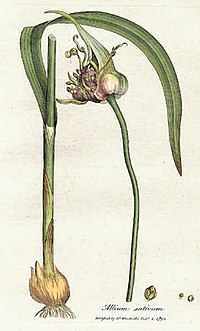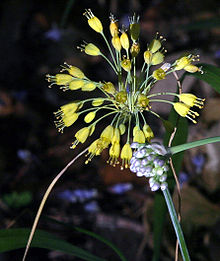Allium: Perbedaan antara revisi
Wagino Bot (bicara | kontrib) k minor cosmetic change |
Wagino Bot (bicara | kontrib) k minor cosmetic change |
||
| Baris 18: | Baris 18: | ||
}} |
}} |
||
[[Berkas:Alliumspecies.jpg|thumb|Spesies ''Allium'', ''[[Allium flavum|A. flavum]]'' di sebelah kiri]] |
[[Berkas:Alliumspecies.jpg|thumb|Spesies ''Allium'', ''[[Allium flavum|A. flavum]]'' di sebelah kiri]] |
||
'''''Allium''''' adalah [[genus]] [[bawang]] yang meliputi bermacam-macam [[tumbuhan bunga]] [[monocotyledonous]] dan di dalamnya termasuk [[bawang merah]], [[bawang putih]], [[bawang kucai]], [[bawang daun]], [[bawang bombai]], dan [[bawang prei]]. [[:en:Genus name|Nama genus]] ''Allium'' merupakan kata [[bahasa Latin|Latin]] untuk [[bawang putih]];<ref name="quattrocchi2000">Umberto Quattrocchi. 2000. ''CRC World Dictionary of Plant Names'' volume I, page 91. CRC Press: Boca Raton; New York; Washington,DC;, USA. London, UK. ISBN 978-0-8493-2673-8 (set)</ref> Linnaeus menggunakan kata ''allium'' untuk menamai genus ini. Sejumlah sumber merujuk kepada kata Yunani αλεω (''aleo''; "menghindari") karena alasan bau bawang putih.<ref name=Block2010>{{cite book |
'''''Allium''''' adalah [[genus]] [[bawang]] yang meliputi bermacam-macam [[tumbuhan bunga]] [[monocotyledonous]] dan di dalamnya termasuk [[bawang merah]], [[bawang putih]], [[bawang kucai]], [[bawang daun]], [[bawang bombai]], dan [[bawang prei]]. [[:en:Genus name|Nama genus]] ''Allium'' merupakan kata [[bahasa Latin|Latin]] untuk [[bawang putih]];<ref name="quattrocchi2000">Umberto Quattrocchi. 2000. ''CRC World Dictionary of Plant Names'' volume I, page 91. CRC Press: Boca Raton; New York; Washington,DC;, USA. London, UK. ISBN 978-0-8493-2673-8 (set)</ref> Linnaeus menggunakan kata ''allium'' untuk menamai genus ini. Sejumlah sumber merujuk kepada kata Yunani αλεω (''aleo''; "menghindari") karena alasan bau bawang putih.<ref name=Block2010>{{cite book|author=Eric Block|title=Garlic and Other Alliums: The Lore and the Science|publisher=Royal Society of Chemistry|year=2010|isbn=978-0-85404-190-9}}</ref><!-- The almost universal eating and [[cooking]] of parts of the plants owes to the large variety of flavours and textures of the species. After cultivation from time immemorial about a dozen species are economically important as crops, or garden [[vegetable]]s, and an increasing number of species are important as ornamental plants.<ref name=Block2010/><ref name=Davies>{{cite book | author=Dilys Davies | title=Alliums: The Ornamental Onions | publisher=Timber Press | year=1992 | isbn= 0-88192-241-2}}</ref>--> |
||
<!-- |
<!-- |
||
The allocation of a plant to the ''Allium'' genus is [[Plant taxonomy|taxonomically]] difficult and [[species]] boundaries are unclear. Most authorities accept about 750 species.<ref name="hirschegger2010">Pablo Hirschegger, Jernej Jaške, Peter Trontelj, and Borut Bohanec. 2010. "Origins of ''Allium ampeloprasum'' horticultural groups and a molecular phylogeny of the section Allium (''Allium''; Alliaceae)". ''Molecular Phylogenetics and Evolution'' '''54'''(2):488-497. {{doi|10.1016/j.ympev.2009.08.030}}</ref> Estimates of the number of species have been as low as 260,<ref name="rahn1998"/> and as high as 979.<ref>[http://www.theplantlist.org/tpl/search?q=Allium "Kew Checklist of Plants"]</ref> The [[type species]] for the genus is ''[[Garlic|Allium sativum]]''.<ref name="ingallium">''Allium'' In: Index Nominum Genericorum. In: [[Regnum Vegetabile]] (see ''Pranala luar'' below).</ref> |
The allocation of a plant to the ''Allium'' genus is [[Plant taxonomy|taxonomically]] difficult and [[species]] boundaries are unclear. Most authorities accept about 750 species.<ref name="hirschegger2010">Pablo Hirschegger, Jernej Jaške, Peter Trontelj, and Borut Bohanec. 2010. "Origins of ''Allium ampeloprasum'' horticultural groups and a molecular phylogeny of the section Allium (''Allium''; Alliaceae)". ''Molecular Phylogenetics and Evolution'' '''54'''(2):488-497. {{doi|10.1016/j.ympev.2009.08.030}}</ref> Estimates of the number of species have been as low as 260,<ref name="rahn1998"/> and as high as 979.<ref>[http://www.theplantlist.org/tpl/search?q=Allium "Kew Checklist of Plants"]</ref> The [[type species]] for the genus is ''[[Garlic|Allium sativum]]''.<ref name="ingallium">''Allium'' In: Index Nominum Genericorum. In: [[Regnum Vegetabile]] (see ''Pranala luar'' below).</ref> |
||
| Baris 129: | Baris 129: | ||
=== Buku === |
=== Buku === |
||
* [http://books.google.ca/books?id=dE7a8SJ9Q7AC Haim D. Rabinowitch, Lesley Currah. ''Allium crop science: recent advances.''] CABI Publishing Series, 2002. ISBN 978-0-85199-510-6 |
* [http://books.google.ca/books?id=dE7a8SJ9Q7AC Haim D. Rabinowitch, Lesley Currah. ''Allium crop science: recent advances.''] CABI Publishing Series, 2002. ISBN 978-0-85199-510-6 |
||
* {{cite book |
* {{cite book|author=Block, E.|title=Garlic and Other Alliums: The Lore and the Science|publisher=Royal Society of Chemistry|year=2010|isbn=978-0-85404-190-9}} |
||
* {{cite book |
* {{cite book|author=Brewster, J. L.|title=Onions and Other Alliums|publisher=CABI Publishing|year=2008|isbn= 978-1-84593-399-9}} |
||
* {{cite book |
* {{cite book|author=Davies, D.|title=Alliums: The Ornamental Onions|publisher=Timber Press|year=1992|isbn= 0-88192-241-2}} |
||
* {{cite book |
* {{cite book|author=Rabinowitch, H. D., Currah, L.|title=Allium Crop Sciences: Recent Advances|publisher=CABI Publishing|year=2002|isbn= 0-85199-510-1}} |
||
* {{cite book |
* {{cite book|author=Woodward, P.|title=Garlic and Friends: The History, Growth and Use of Edible Alliums|publisher=Hyland House|year=1996|isbn= 1-86447-009-7}} |
||
=== Artikel === |
=== Artikel === |
||
Revisi per 15 Maret 2016 19.01
| Allium | |
|---|---|

| |
| Allium sativum | |
| Klasifikasi ilmiah | |
| Kerajaan: | |
| Divisi: | |
| Kelas: | |
| Ordo: | |
| Famili: | |
| Genus: | Allium
|
| Spesies tipe | |
| Allium sativum | |

Allium adalah genus bawang yang meliputi bermacam-macam tumbuhan bunga monocotyledonous dan di dalamnya termasuk bawang merah, bawang putih, bawang kucai, bawang daun, bawang bombai, dan bawang prei. Nama genus Allium merupakan kata Latin untuk bawang putih;[1] Linnaeus menggunakan kata allium untuk menamai genus ini. Sejumlah sumber merujuk kepada kata Yunani αλεω (aleo; "menghindari") karena alasan bau bawang putih.[2]

Taksonomi
Taksonomi genus Allium sukar dipahami, karena memuat pemerian salah yang berkembang luas. Allium spicatum oleh banyak penulis diperlakukan sebagai Milula spicata, satu-satunya spesies dalam genus monospesifik Milula. Pada tahun 2000, dibuktikan merupakan anggota genus Allium.[3]
Spesies
Spesies termasuk:
- Allium acuminatum — tapertip onion, Hooker's onion
- Allium allegheniense — Appalachian onion
- Allium ampeloprasum (juga disebut Allium porrum) — bawang prei liar (berdaun lebar)
- A. ampeloprasum var. ampeloprasum — elephant garlic
- A. ampeloprasum var. kurrat — kurrat
- A. ampeloprasum var. porrum — bawang prei
- Allium anceps — twinleaf onion
- Allium angulosum — mouse garlic
- Allium aflatunense — flowering onion
- Allium atrorubens — dark red onion
- Allium caeruleum — blue globe onion
- Allium campanulatum — dusky onion
- Allium canadense — Canadian garlic
- Allium cepa — bawang bombai
- Allium cernuum — nodding onion
- Allium chinense — Chinese onion, Chinese scallion, Japanese scallion, Oriental onion
- Allium fistulosum — Welsh onion
- Allium galanthum
- Allium giganteum — giant onion
- Allium hollandicum — flowering onion
- Allium libani — Lebanese onion
- Allium neapolitanum — white garlic
- Allium nevii — Nevius' garlic
- Allium nigrum — black garlic
- Allium oleraceum — field garlic
- Allium oschaninii — bawang merah
- Allium paradoxum — few-flowered garlic
- Allium ramosum — fragrant garlic
- Allium sativum — bawang putih
- Allium schoenoprasum — chives
- Allium scorodoprasum — sand leek
- Allium siculum — Mediterranean bells, Sicilian honey garlic
- Allium sieberianum — Schult.f.
- Allium stipitatum — Persian shallot
- Allium textile — prairie onion
- Allium tricoccum — wild leek, ramp
- Allium triquetrum — three-cornered leek, triquetous garlic
- Allium tuncelianum — Tunceli garlic, Ovacik garlic
- Allium tuberosum — Chinese chives
- Allium ursinum — buckrams, wild garlic, broad-leaved garlic, wood garlic, bear's garlic
- Allium vineale — crow garlic, wild garlic
Toksisitas
Anjing dan kucing sangat rentan terhadap keracunan setelah memakan spesies bawang tertentu.[2][4]
Referensi
- ^ Umberto Quattrocchi. 2000. CRC World Dictionary of Plant Names volume I, page 91. CRC Press: Boca Raton; New York; Washington,DC;, USA. London, UK. ISBN 978-0-8493-2673-8 (set)
- ^ a b Eric Block (2010). Garlic and Other Alliums: The Lore and the Science. Royal Society of Chemistry. ISBN 978-0-85404-190-9.
- ^ Nikolai Friesen, Reinhard M. Fritsch, Sven Pollner and Frank R. Blattner. 2000. "Molecular and Morphological Evidence for an Origin of the Aberrant Genus Milula within Himalayan Species of Allium (Alliacae)". Molecular Phylogenetics and Evolution 17(2):209-218. DOI:10.1006/mpev.2000.0844
- ^ Cope RB. Toxicology Brief: Allium species poisoning in dogs and cats. Vetinary Medicine 2005
Pustaka
Buku
- Haim D. Rabinowitch, Lesley Currah. Allium crop science: recent advances. CABI Publishing Series, 2002. ISBN 978-0-85199-510-6
- Block, E. (2010). Garlic and Other Alliums: The Lore and the Science. Royal Society of Chemistry. ISBN 978-0-85404-190-9.
- Brewster, J. L. (2008). Onions and Other Alliums. CABI Publishing. ISBN 978-1-84593-399-9.
- Davies, D. (1992). Alliums: The Ornamental Onions. Timber Press. ISBN 0-88192-241-2.
- Rabinowitch, H. D., Currah, L. (2002). Allium Crop Sciences: Recent Advances. CABI Publishing. ISBN 0-85199-510-1.
- Woodward, P. (1996). Garlic and Friends: The History, Growth and Use of Edible Alliums. Hyland House. ISBN 1-86447-009-7.
Artikel
- J. G. Dubouzet, K. Shinoda and N. Murata. Phylogeny of Allium L. subgenus Rhizirideum (G. Don ex Koch) Wendelbo according to dot blot hybridization with randomly amplified DNA probes TAG Theoretical and Applied 'Genetics. Volume 95, Number 8, December, 1997
- N. Friesen, R. Fritsch and K. Bachmann. Hybrid origin of some ornamentals of Allium subgenus Melanocrommyum verified with GISH and RAPD. TAG Theoretical and Applied Genetics. Volume 95, Number 8, December, 1997
- A. Samoylov, N. Friesen, S. Pollner, P. Hanelt. Use of chloroplast DNA polymorphisms for the phylogenetic study of Allium subgenus Amerallium and subgenus Bromatorrhiza (Alliaceae) II. Feddes Repertorium Volume 110 Issue 1–2, Pages 103–109, 1999
- Li, R. J., Z. Y. Shang, T. C. Cui, AND J. M. Xu. 1996. Studies on karyotypes and phylogenetic relationship of Allium sect. Caloscordum (Liliaceae) from China. Acta Phytotax. Sin. 34: 288–295. [In Chinese.]
- Li, Q.-Q.; Zhou, S.-D.; He, X.-J.; Yu, Y.; Zhang, Y.-C.; Wei, X.-Q. (21 October 2010). "Phylogeny and biogeography of Allium (Amaryllidaceae: Allieae) based on nuclear ribosomal internal transcribed spacer and chloroplast rps16 sequences, focusing on the inclusion of species endemic to China". Annals of Botany. 106 (5): 709–733. doi:10.1093/aob/mcq177. PMC 2958792
 . Diakses tanggal 8 January 2015.
. Diakses tanggal 8 January 2015. - Sykorova, E.; Fajkus, J.; Meznikova, M.; Lim, K. Y.; Neplechova, K.; Blattner, F. R.; Chase, M. W.; Leitch, A. R. (1 June 2006). "Minisatellite telomeres occur in the family Alliaceae but are lost in Allium". American Journal of Botany. 93 (6): 814–823. doi:10.3732/ajb.93.6.814. Diakses tanggal 8 January 2015.
- Enrico Banfi, Gabriele Galasso & Adriano Soldano. Notes on systematics and taxonomy for the Italian vascular flora. 2. Atti Soc. it. Sci. nat. Museo civ. Stor. nat. Milano, 152 (II): 85-106, Novembre 2011
- ZUBAIDA YOUSAF; ZABTA KHAN SHINWARI; RIZWANA ALEEM QURESHI; MIR AJAB KHAN; SYED SHAHINSHAH GILANI (2004). "CAN COMPLEXITY OF THE GENUS ALLIUM L., BE RESOLVED THROUGH SOME NUMERICAL TECHNIQUES?" (PDF). Pak. J. Bot. 36 (3): 487–501. Diakses tanggal 28 January 2015.
Lain-lain
Pranala luar
- "WCSP". World Checklist of Selected Plant Families. (enter "Allium" in search box).
- Allium At:Index Nominum Genericorum At:References At:NMNH Department of Botany
- Bloomsta.com Florist Community
